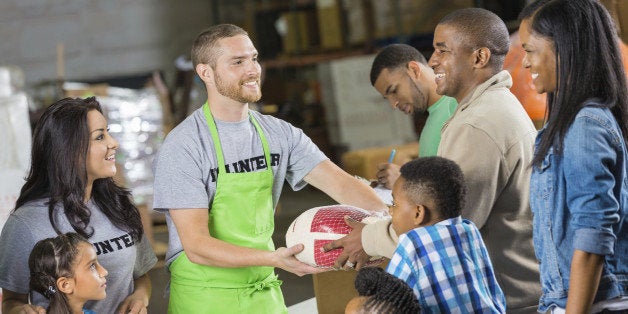
This Thanksgiving as I look forward to enjoying a meal with friends and family, I remember a very different meal that I shared years ago with a young girl named Nalini.
The year was 1993, and as the head of programs at Plan International USA, I traveled to southern India to visit our child survival programs that focused on helping children to fulfill their potential. Nalini was one of these children.
Nalini, who was around nine years old and roughly the same weight as my five-year-old daughter, should have been much taller and heavier; instead she showed signs of malnutrition. Each year, the underlying cause of about 45 percent of all deaths of children under the age of five is poor nutrition, according to World Food Program. In addition, about one-fourth of children in the developing world are stunted due to malnutrition. Stunted children often have irreversible development problems -- both physically and mentally.
Throughout my visit to her town, Nalini followed me, and at the end of the day she grabbed my hand. I followed her through the streets to the only concrete building in the community. The building had a staircase that scaled the outside of the building. We took the stairs to the roof where thousands of peanuts lay drying in the sun. Nalini picked a few of them up and shared them with me. She knew that I must be hungry. Here a child -- who knew the pain of extreme hunger -- hared her food with me.
It is this type of generosity that we are celebrating on Thanksgiving.
Two decades later, I now lead InterAction, a coalition of U.S.-based international NGOs, many focused on reducing hunger and malnutrition on a global scale. At InterAction, we are working to establish systems that enable smallholder farmers to have the security to feed themselves as they also feed the world.
We are at an exciting time in history: We have the means and opportunity to eliminate extreme hunger. However, this possibility requires not only public and private resources but also political will.
In 2010 the U.S. government launched Feed the Future, focused on sustainably increasing agricultural productivity and better nutrition in 19 focus countries in Africa, Asia and Latin America and the Caribbean to provide millions of people a pathway out of extreme hunger and extreme poverty. Working with global leaders, smallholder farmers and other partners, Feed the Future has made substantial gains in reducing hunger and malnutrition globally. In 2013, the initiative provided guidance in management practices and new technologies to nearly 7 million farmers, and more than 12.5 million children received nutrition solutions to help them build stronger, more successful futures. Congress has introduced and is working to pass bipartisan legislation in both the Senate and House to codify Feed the Future to build and improve upon the gains already made to tackle hunger and malnutrition. Since 1990, hunger in developing countries has fallen 39 percent, according to the 2014 Global Hunger Index. Yet, more than 805 million people live in extreme hunger; with focus and increased determination we can reduce that number to zero.
U.S. nongovernmental organizations (NGOs) are also helping this fight. In 2012, InterAction pledged that our members would commit $1 billion in private resources over the next three years towards eliminating extreme hunger. That pledge has now been increased to $1.5 billion. These resources come from the generous support of individuals, foundations and corporations who believe in our members' causes and approaches. With programs in every country in the world, U.S. NGOs are at the forefront on fighting hunger and malnutrition. InterAction members work with local communities to help people become more self-sufficient, and their efforts complement U.S. government programs such as Feed the Future. But U.S. NGOs cannot solve issues of access to affordable, nutritious food by working alone.
That's why this May, InterAction and USAID announced a first-of-its-kind agreementaimed at maximizing the U.S. government's and U.S. NGOs' ability to fight extreme hunger and malnutrition. This new partnership redefines and explores innovative ways for USAID and U.S. NGOs to work together. For example, USAID and U.S. NGOs are working in six countries with both public and private funding to increase nutrition during the first 1,000 days of each child's life. Our goal is to reduce future child stunting by 20 percent. By working together to map nutrition efforts, monitor coverage and impact on nutritional status, and scale key evidence-based interventions, we will greatly reduce malnutrition and stunting. This collaboration helps both publicly-funded U.S. government programs and privately-funded U.S. NGO programs align and complement each other for a larger impact.
To achieve our hunger and nutrition goals it will take everyone -- governments, corporations, civil society organizations, universities, think tanks and individuals -- working together, with shared goals and sustained efforts.
So, as we think about our Thanksgiving traditions, I would encourage you to include#GivingTuesday into your tradition. InterAction and our members work all year long to advance sustainable solutions that will produce societies that can feed themselves. You can help support our work by asking your member of Congress to support legislation to codify Feed the Future or personally supporting our member NGOs.
We can end extreme hunger within a generation, but only if we commit now.
This post is part of a series produced by The Huffington Post and the NGO alliance InterAction in celebration of #GivingTuesday, which will take place this year (2014) on December 2. The idea behind #GivingTuesday is to kickoff the holiday-giving season, in the same way that Black Friday and Cyber Monday kickoff the holiday-shopping season. We'll be featuring posts from InterAction partners and others all month in November. To see all the posts in the series, visit here; follow the conversation on Twitter via #GivingTuesday and learn more here. For more information about InterAction, visit here.
